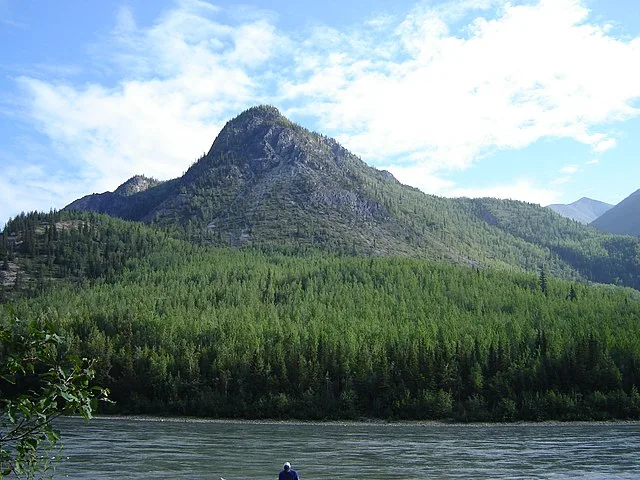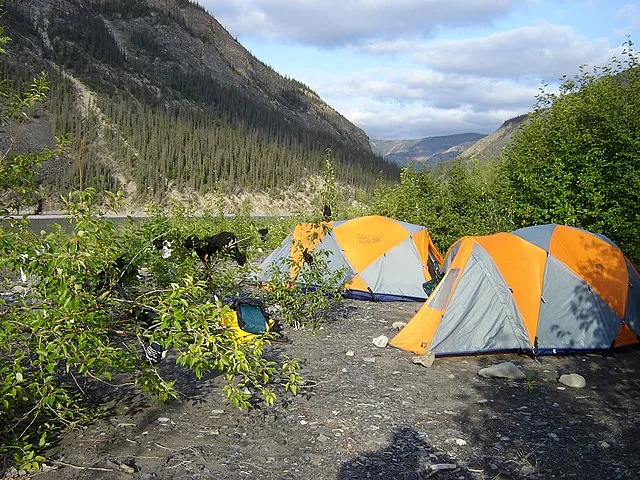The CanaTREK team returned to the Northwest Territories this year (June & July, 2016), and focused their approach from the southern area of the Nahanni Park boundary. This challenging trip marked their third attempt on NWT’s remote highpoint and included some more technical rock climbing.

Author: Fort Simpson Chamber of Commerce – wikimedia.org
This 9,098 foot summit had been proving very difficult to reach with the weather playing the crucial deciding factor the frist two times. Well, like they say, third time’s the charm. This expedition also entailed a paddling component down the “Upper Flat River”, both before and after the climb.
The Thunder Mountain (Mt. Nirvana) Agenda/Itinerary
(An Overland, Human-Powered Expedition Without Air Support)
June 10 – July 5, 2016
Team
Eric Gilbertson and Len Vanderstar, Assisted by Luke Weyman and Ron Vanderstar
June 10 – Eric departs Seattle on Greyhound bus
June 11 – Greyhound bus to Smithers
June 12 – Drive to Simpson Lake, Yukon
June 13 – Drive to Tungsten, NWT, start paddling from near Divide Lake
June 14 – Paddle the Upper Flat River – 45 km to staging location for the trek
June 15 – Paddle to takeout, bushwhack up unnamed valley
June 16 – Bushwhack past valley of chaos, camp in the woods
June 17 – Hike through third pass, camp in valley below
June 18 – Hike to East Face base camp
June 19 – Climb to base of upper snowfield, retreat after avalanches
June 20 – Start 12:45am when snow firm, climb to summit ridge
June 21 – 7:00am Eric and Len reach summit, rappel down, wait for night for snow to stabilize. Ron and Luke depart, trek back to the boats. They will then have an 8 to 9 day paddle down the Flat/Sth Nahanni/Laird to Blackstone Landing.
June 22 – Eric and Len arrive in camp at 5am, rest day
June 23 – Eric scouts escape couloir to North Cirque
June 24 – Eric climbs Peak 1941 south of camp
June 25 – Eric and Len climb couloir to North Cirque, camp at nearby lake
June 26 – Hike to base camp at SW face of
June 27 – Hike west, climb Peak 46 (first ascent), camp near glacier at base
June 28 – Cross pass near Mt Wollaga, drop down to Flat River Valley
June 29 – Bushwhack along Flat River. 13 hrs to progress 5 miles
June 30 – Bushwhack along Flat River, reach hunters cabin for night
July
July 1 – Hike along ATV trail to Tungsten, reach Ron’s Jeep, drive 8 hours to Liard Hot Springs
July 2 – Drive 7hrs to Blackstone Landing, pick up Ron and Luke, drive back to Liard Hot Springs
July 3 – Drive 15 hrs to Smithers, BC
July 4 – Eric departs Smithers on Greyhound bus
July 5 – Eric arrives in Seattle 27 hours later

Author : Fort Simpson Chamber of Commerce – wikimedia.org
About Nahanni National Park
The following provides some further details regarding Nahanni National Park and the areas that were traveled through. (Note – some information is compliments of Parks Canada’s South Nahanni River Touring Guide.)
Located in Canada’s Northwest Territories, Nahanni National Park Reserve was created in 1976 to protect a portion of the Mackenzie Mountains natural region. Park expansions have since occurred twice. The Park protects the largest remaining glaciers and the highest mountains in the Northwest Territories, large alpine plateaus, karst features and important wildlife habitat.
Nahanni National Park is located within the traditional territory of the Dehcho First Nations, and the Park is co-operatively managed by Parks Canada and the Dehcho First Nations. In 1978, Nahanni National park was declared a United Nations World Heritage Site for its exceptional natural beauty and its globally unique geological processes. In 1987, the South Nahanni River was designated as a Canadian Heritage River. It’s a premier wilderness river area with magnificent scenery and offers a great opportunity to discover the local culture of the area. Other rivers worthy of paddling consideration within the Park include the Little Nahanni River and Flat River. Parks Canada has a South Nahanni River Touring Guide that highlights the river from its headwaters (Moose Ponds) to its confluence with the Laird River, 565 km downstream. Ken Madsen’s book, Paddling in the Yukon, also describes the Little Nahanni.
Thunder Mountain and the Ragged Range
The highest mountain in NWT is known by the Dehcho elders as Thunder Mountain (in translation), and by the climbing community as Nirvana. This mountain is located in the heart of the Ragged Range, so named for the spectacular formation of jagged granite peaks. As it hardened and cooled, it pushed sedimentary rock up from below, and over time the upper layers of sedimentary rock eroded, exposing the granite of the Ragged Range. The last period of glaciation, which ended about 10,000 years ago, sculpted the formation seen today.
The largest tufa mounds in Canada are situated in close proximity to Rabbit Kettle Lake.
The more recent Wisconsin glaciation that shaped the Ragged Range did not reach the South Nahanni River valley from Rabbit Kettle Lake to Virginia Falls. Below Virginia Falls, the Park has not seen glaciation in more than 200,000 years. Flowing water, rather than ice, shaped the lower canyons. As the mountains grew over time, the river was able to stay its course, more or less, carving through the rising rock strata, creating the canyons and preserving the meanders that developed when the river flowed across a flat valley.
Conclusion
The CanaTREK team successfully reached the summit of Thunder Mountain (Mt. Nirvana) in the Northwest Territories after two previous attempts. The expedition involved a combination of paddling and trekking, starting from Tungsten, NWT, and navigating through challenging terrain to reach the base camp. Nahanni National Park, where Thunder Mountain is located, boasts exceptional natural beauty and is home to significant geological features and wildlife habitats. The South Nahanni River, designated a Canadian Heritage River, offers opportunities for wilderness exploration and paddling adventures through stunning landscapes.
FAQs
-
What is Thunder Mountain?
Thunder Mountain, also known as Mt. Nirvana, is the highest peak in the Northwest Territories, located in the Ragged Range within Nahanni National Park.
How did the CanaTREK team reach the summit?
The CanaTREK team reached the summit of Thunder Mountain through a combination of paddling and trekking, starting from Tungsten, NWT, and navigating challenging terrain.
What opportunities does the South Nahanni River offer?
The South Nahanni River offers opportunities for wilderness exploration and paddling adventures through stunning landscapes.